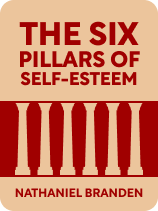

This article is an excerpt from the Shortform book guide to "The Six Pillars of Self-Esteem" by Nathaniel Branden. Shortform has the world's best summaries and analyses of books you should be reading.
Like this article? Sign up for a free trial here .
What does self-acceptance have to do with self-esteem? What’s the key difference between self-acceptance and self-esteem?
Self-acceptance is an essential ingredient of self-esteem. However, it’s not the same as self-esteem. Self-esteem is a state you experience. Self-acceptance is an action you take.
Keep reading to learn about the role of self-acceptance in self-esteem, according to psychotherapist and self-esteem expert Nathaniel Branden.
Why Accepting Yourself Matters for Self-Esteem
According to psychotherapist and self-esteem expert Nathaniel Branden, there’s an important connection between self-acceptance and self-esteem. In his book The Six Pillars of Self-Esteem, he conceptualizes self-acceptance as the second of the six pillars. Further, Branden explains that you benefit from your general self-acceptance and from each individual level of accepting yourself:
- At the first level of accepting yourself, you’re on your own side. On some fundamental level, you’re born believing that you’re valuable and deserve to exist simply because you’re alive, though some people lose this belief as they age. This primal belief propels us to ask for the help we need and demand the respect we deserve.
- At the second level of accepting yourself, you’re willing to experience all your emotions and behavior—both good and bad. This doesn’t mean you approve of them, just that you don’t deny them. To accept your feelings, Branden explains, use both your body and mind. Breathe deeply to feel the emotion and then take ownership of it—instead of tensing or denying it.
- At the third level of accepting yourself, you treat yourself with kindness. To do this, Branden argues, you accept your poor behavior, then empathetically question why you behaved poorly. (Shortform note: In Nonviolent Communication, psychologist Marshall Rosenberg asserts that poor behavior stems primarily from unmet needs, so he suggests empathetically asking yourself questions like, “What unmet need prompted me to act that way?”)
Looking at each aspect of this pillar, first, being on your own side is the foundation on which you build self-esteem. Without this baseline belief that your life is worth fighting for, you won’t make the behavioral changes necessary to effectively improve your self-esteem. (Shortform note: Although Branden doesn’t draw this connection, this may relate to the necessity of loving your life, as we discussed previously.)
Second, being willing to experience your actions and emotions matters because you can only change what you accept. Branden rejects the idea that accepting your reality implies resignation to it; rather, you find the motivation to change only when you accept the reality you dislike. For example, Branden notes that you’ll only act to improve your self-esteem if you accept that you have low self-esteem. If you deny that you have low self-esteem, why would you try to change it?
(Shortform note: In The Power of Now, Tolle also emphasizes the importance of accepting your current reality, but he recommends accepting the situation you’re in at a particular moment—not an aspect of yourself, like your level of self-esteem.)
Third, treating yourself with kindness makes you less likely to repeat your mistakes. Compassionately reflecting on why you acted poorly allows you to address the root cause of that mistake. By doing this, you avoid damaging your self-esteem—so you don’t behave in negative ways that reflect damaged self-esteem in the future.
(Shortform note: Treating yourself with kindness may also benefit the people around you. For example, one psychologist notes that new mothers who treat themselves with kindness when they make mistakes may encourage friends who give birth after they do to do the same.)
Fourth, Branden adds that accepting your unwillingness to accept something naturally weakens that unwillingness. Resistance requires something to fight against; if there’s nothing, it naturally fades. (Shortform note: One healer adds that the key to acceptance is to understand why that resistance exists. Knowing it’s there for a good reason may help you relax and make you more open to whatever you’re resisting.)
Finally, Branden warns that if you don’t accept yourself, you risk not fulfilling your potential. Many of us resist our strengths because we fear the responsibility they come with. But unless you accept them, you can’t take full advantage of them.
(Shortform note: In contrast, some experts warn that relying too heavily on your strengths may also prevent you from fulfilling your potential. For example, one man’s penchant for planning may make him unable to delegate, which harms his work. So accept that the same quality can be both good and bad in different situations and work on specific aspects of it when necessary.)

———End of Preview———
Like what you just read? Read the rest of the world's best book summary and analysis of Nathaniel Branden's "The Six Pillars of Self-Esteem" at Shortform .
Here's what you'll find in our full The Six Pillars of Self-Esteem summary :
- Exactly how to behave to improve your self-esteem
- Why you need to take responsibility for your life and actions
- Why so many self-esteem techniques don't work






